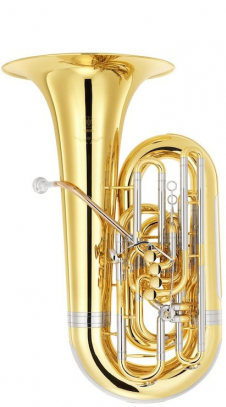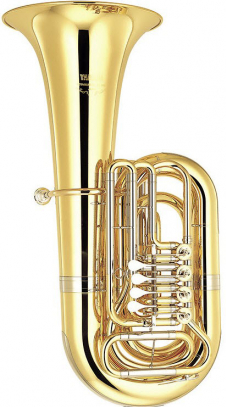The Brass Family, Explained
An overview of brass instruments and how they work.
Like woodwinds, brass instruments are part of the wind instrument category, with the most common being trumpet, cornet, flugelhorn, trombone, tuba, euphonium, baritone horn, alto (tenor) horn and French horn. Although these have some similarities with woodwinds, there are numerous differences as well. Here’s a guide to the family of brass instruments.
Differences in Construction and Sound Production
While woodwinds can be made of different materials — not just wood, as the name implies, but metals such as silver or gold — most brass instruments are made of brass tubing of various diameters and shapes, with a detachable mouthpiece at one end and a flared bell at the other. Some models may be silver- or gold-plated.
Whereas a woodwind player blows directly into a headjoint, mouthpiece or reed to create a column of air inside the instrument that becomes a sound, brass players vibrate (“buzz”) their lips against the mouthpiece instead. Experienced players can access the full range of their instruments by varying the intensity of their lip vibrations, something known as embouchure.
On woodwind instruments, the pitch is usually changed when the player covers and uncovers different holes on the instrument’s body. On brass instruments, , the musician instead opens or closes one or more of the valves on the instrument (in addition to manipulating their embouchure) to change pitch. When a valve opens, it allows the air to flow into a supplementary tube, thus extending the total tube length and lowering the pitch. A valve serves to alter the length of the instrument’s interior, changing how far air has to travel and resulting in a greater number of possible notes. Valves make it easy to change the length of the tube, thereby enabling many different notes to be played. All brass instruments utilize valves, with the exception of the slide trombone, which features a sliding tube that changes the tube length as it is manually extended and contracted by the player.
Two different valve types are used in brass instruments: piston and rotary. The former work vertically: you press down, the valve opens; you release, and it closes. A rotary valve accomplishes the same thing but does it differently. Instead of pressing down on a button, you press a lever that turns a circular rotor, opening channels that let the air flow into additional tubing. In general, piston valves are considered more precise and rotary valves smoother.
Trumpet, Cornet and Flugelhorn
The trumpet has come a long way from its ancient ancestors made of sea shells, animal horns and pieces of ivory — even human bones. Archeological evidence shows that the first metal trumpets, made of silver or bronze, were used by the ancient Egyptians starting in 1500 BC. The ancient Greeks and Romans later employed similar instruments.
Back then, such instruments were primarily used for military signaling or religious ceremonies. They were akin to a bugle, which relies strictly on the player’s mouth techniques to change pitch. It wasn’t until the 18th century that instrument designers added valves to the trumpet. That revolutionized the instrument because it allowed the musician to play all the notes in a chromatic scale in several octaves.
Having that degree of melodic control transformed the trumpet into an instrument widely used in classical music and later, jazz orchestras and ensembles. If you’ve heard recordings of masters like Miles Davis, Dizzy Gillespie or Louis Armstrong, you know how expressive and musical a trumpet can be.
Most modern-day trumpets feature three valves. Pressing the first valve lowers the pitch by a whole step, the second by a half step and the third by one-and-a-half steps. By using various combinations of the valves, including some that require pressing the valve only halfway (a technique known as “half-valving”), the player can get access to many different notes.

The most common modern version is the B♭ trumpet, which offers a range of Concert F# to D two octaves higher, though there are other kinds too, including the C trumpet, the smaller, higher-pitched piccolo trumpet, and the larger, lower-pitched bass trumpet.
The cornet is similar to the trumpet, but has a more conical bore (interior chamber), giving it a mellower, rounder tone than a trumpet. It’s also smaller and easier to hold, which makes it a good first instrument for students. That said, cornets are also the choice of many advanced and professional players — particularly those in military-style brass bands — because of their unique tone. The most common model is tuned to B♭; it has the same fingerings and range as a B♭ trumpet. Less common is the higher-pitched E♭ soprano cornet.

Another variation is the flugelhorn, which is similar in design to a trumpet, but with a bore that’s even more conical than the cornet, resulting in a mellower tone. Its name derives from the German world “flugel,” which means “wing,” referring to the instrument’s shape. Like the trumpet and cornet, most flugelhorns are pitched to B♭, though some models are pitched to C. Flugelhorns are used in jazz, as well as in brass and marching bands and orchestras.

Trombone
The first known use of the trombone, originally called a “sackbut,” was in 15th-century religious music. By the 18th century, their popularity had grown, and they became common in classical and popular music as well. Nowadays, trombones are ubiquitous as section and solo instruments in jazz, pop and classical ensembles.
Trombone mouthpieces come in a variety of sizes. Smaller-sized mouthpieces create a brighter sound and make it easier for the player to reach high notes.
On a slide trombone, which is the most commonly used trombone type, the musician moves a telescoping section of tubing (called a “slide”) forward and backward to lengthen or shorten the total tube length, thus altering the pitch. Using the slide, the trombonist can smoothly glide up or down from one note to the next, allowing for legato phrasing that is unique among brass instruments.
The majority of trombones in use are tenor trombones, which have a range from Concert E to F three octaves higher.

Other varieties include the bass trombone and the alto trombone.


Not all trombones have slides. Valve trombones, which are much less common, change pitch using three or four piston valves. These instruments are somewhat easier for student trumpeters to learn; in addition, fast, difficult passages are easier to perform. However, they have a slightly less “open” tone than traditional slide trombones.

Tuba, Sousaphone, Euphonium, Baritone Horn and Alto (Tenor) Horn
Invented in 1835, the tuba (named after the Latin word for “tube”) is a relative newcomer to the world of brass instruments. It’s also the lowest-pitched and the largest.
If you straightened out the tube of a B♭ tuba — the most common of the many variations of the instrument — it would be close to 18 feet long. Adding to its ability to produce low notes, the tuba has the widest bore of any instrument in the brass family.
Because of their low range, tubas are used for bass parts in orchestras, marching bands, and other brass ensembles. They’re also commonly used instead of stringed basses in traditional New Orleans jazz and ragtime bands.
Like trumpets, tubas utilize valves that allow the player to enlarge the tube length to change pitch. However, the number of valves varies. Tubas can have three to six valves; how many there are affects the range and intonation.
Three-valve tubas are typically only used by beginners and novice players because they’re easier to learn. Advanced tuba players typically use instruments that have four or more valves. You need at least four valves to play all the notes in a tuba’s standard range.
The tuba has quite a few variants. The C tuba is slightly higher-pitched (it has two feet less tubing) than the B♭ version, but its clearer tone makes it the favorite of orchestral tubists. Other varieties include the E♭ tuba, F tuba and the baritone tuba.
A related instrument is the sousaphone, designed by composer and conductor John Phillip Sousa in 1890 specifically for use in marching bands. Its body wraps around the player and is lighter than a typical tuba. It only has three valves, so its lowest note is higher than a four-valve B♭ tuba.
Other related instruments include the euphonium, the baritone horn and the alto horn (sometimes called a “tenor” horn). The euphonium looks somewhat like a tuba but has a range that’s an octave higher than a B♭ tuba. Euphoniums are frequently found in concert bands, but it can be used as a solo instrument. The baritone horn, which is pitched in B♭, has the same tonal range as the euphonium. As a result, many euphonium players also play the baritone, and vice versa.

Compared to a euphonium, the timbre of a baritone horn is brighter and its bore is considerably thinner. A euphonium with the bell and pistons facing forward is sometimes called a baritone to differentiate it from a true euphonium.

The alto (tenor) horn is pitched in the key of E♭, five tones lower than a trumpet, and is sometimes played by trumpeters. It’s similar in appearance to a euphonium and is most commonly used in brass and marching bands.

French Horn
The name “French horn” is a misnomer because the instrument, which was invented in the mid-1800s, actually originated in Germany. The contemporary French horn has a distinct, mellow tone that’s highly expressive. It excels as both a solo instrument and as part of an orchestral horn section. Typically, you’ll find four French horns in an orchestra.
The French horn is the only brass instrument that requires the musician to place one hand inside the bell while playing. This practice, known as hand-stopping, allows the player to change the tube length manually and thus change the pitch by a semitone or whole tone. It originated before the invention of the valve, and so is no longer strictly necessary. Nevertheless, it’s still an important part of French horn technique.
There are four different types of French horns. The single horn, which has three rotary valves, is used almost exclusively by beginners and comes in two varieties: the F horn and the B♭ horn.

The F French horn contains more tubing than its B♭ cousin and is thus pitched lower. The B♭ horn is easier to play, but the F horn produces more notes and a purer tone.
Advanced players often use double horns, which contain a second complete tube section and are like having a B♭ and F horn in one, thus increasing the range of notes available to the player; a fourth valve switches the horn between its two discrete sections.

Another variety, the descant double, has a B♭ and a high-F section, which sounds an octave higher than the regular F section.

Perhaps the ultimate French horn type is a triple horn.

This is really a full-double horn that also includes a high-F horn for playing in the higher ranges. Although the overall pitch range of the horn is technically unchanged, the high-F side of the horn allows it to be more stable in the higher range.
Learn more about Yamaha trumpets, cornets, flugelhorns, trombones, tubas, euphoniums, baritone horns, alto (tenor) horns and French horns.



















